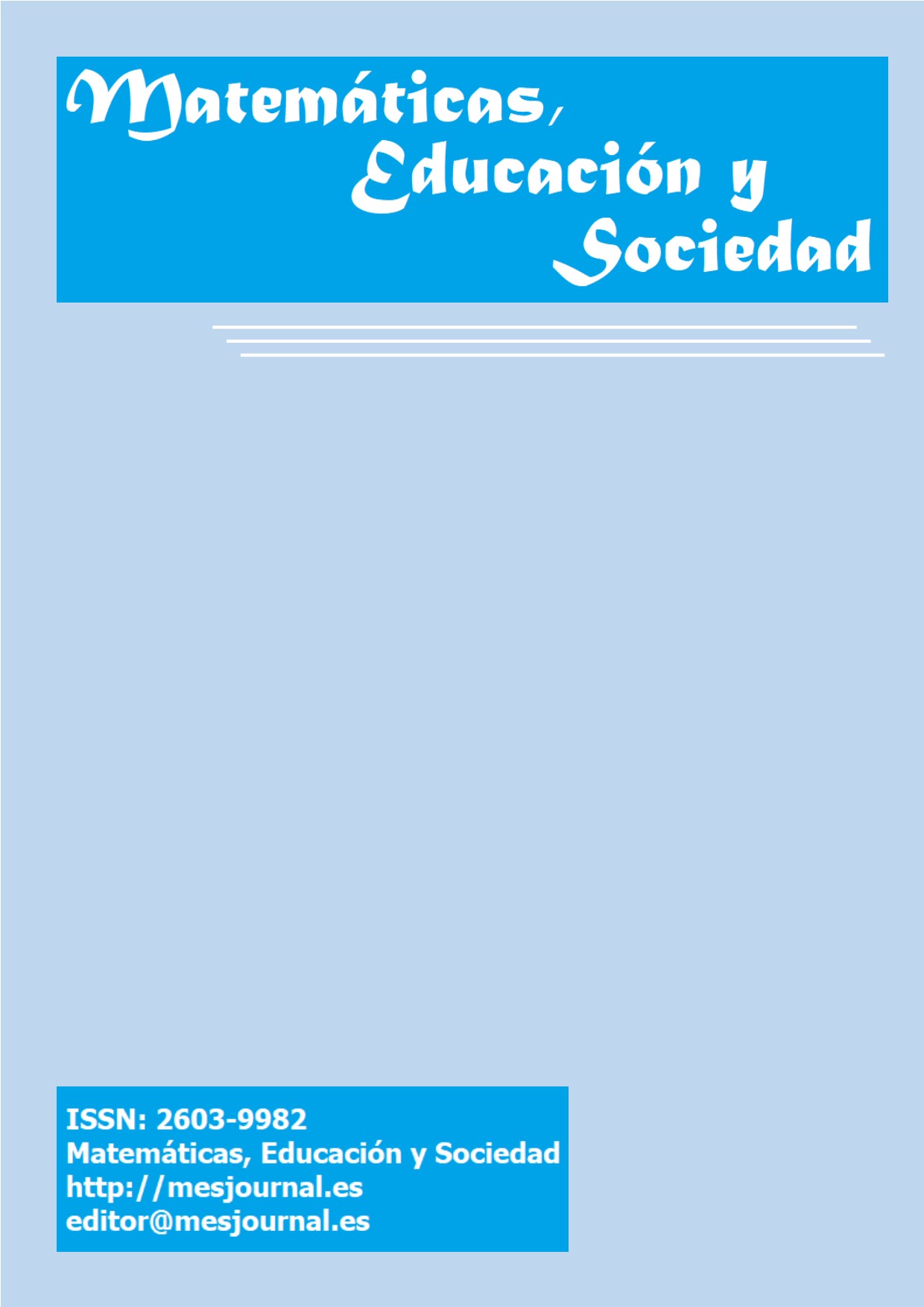La metodología Context-Based Approach en STEM: Modelización de datos meteorológicos
Contenido principal del artículo
Resumen
GeoGebra es un software de matemáticas dinámicas para todos los niveles educativos que reúne geometría, álgebra, hoja de cálculo, gráficos, estadística y cálculo en un solo programa fácil de usar. Este estudio se centra en cómo este recurso puede usarse para mejorar la enseñanza en STEM, mediante una propuesta didáctica que sigue una metodología de Context-Based Approach, donde el contexto es una necesidad real de una empresa que se puede llevar al aula de Ingeniería para implementar buenas prácticas en la enseñanza STEM. El propósito concreto es que, a partir de las observaciones puntuales, necesitamos mostrar información sobre la densidad y altura de las nubes. Para ello debemos calcular los puntos que definen una zona de nubes y encontrar una representación poligonal de la superficie que ocupa.
Descargas
Detalles del artículo
Esta obra está bajo una Licencia Creative Commons Atribución 3.0 España
Bibliografía
Artigue, M. (2002). Learning mathematics in a CAS environment: The genesis of a reflection about instrumentation and the dialectics between technical and conceptual work. International Journal of Computers for Mathematical Learning, 7, 245–274.
Artigue, M., Drijvers, P., Lagrange, Jb, Mariotti, M. A., y Ruthven, K. (2009). Technologies numériques dans l'enseignement des mathématiques, où en eston dans les recherches et dans leur intégration? En C. Ouvrier-Buffet y M.J. Perrin-Glorian (Eds.), Approches plurielles en didactique des mathématiques; Apprendre à faire des mathématiques du primaire au supérieur: quoi de neuf? (pp. 185–207). Paris: Université Paris Diderot Paris 7.
Bronfenbrenner, U. (1979). The ecology of Human Development. Cambridge: Harvard University Press. (Trad. Cast.: La ecología del desarrollo humano. Barcelona: Ediciones Paidós, 1987).
Centroide. (2017) [En línea]. Disponible en: http://pier.guillen.com.mx/algorithms/07-geometricos/07.8-centroide.htm. [Accedido: 14-jun-2017].
Doerr, H. M., y Zangor, R. (2000). Creating meaning for and with the graphing calculator. Educational Studies in Mathematics, 41, 143–163.
Fraser, B. J., Tobin, K., y McRobbie, C. J. (Eds.) (2012). Second international handbook on science education. New York: Springer.
Henderson, C., Beach, A., y Finkelstein, N. (2011). Facilitating change in undergraduate STEM instructional practices: An analytic review of the literatura. Journal of research in science teaching 48(8), 952–984.
Hirsch, C.R. and McDuffie, A.R. (Ed.) (2016) Annual Perspectives in Mathematics Education 2016: Mathematical Modeling and Modeling Mathematics. National Council of Teachers of Mathematics Editors
Hohenwarter, M., Borcherds, M., Ancsin, G., Bencze, B., Blossier, M., Delobelle, A., . . . Sturr, G. (2017). GeoGebra (Version 5.0.352.0-3D) [Programa informático]. Linz, Austria: International GeoGebra Institute. Recuperado de http://www.geogebra.org/
Hohenwarter, M., y Hohenwarter, J. (18 de septiembre de 2009). Geogebra. Obtenido de: www.geogebra.org
Kelly, A.E., Lesh, R.A. y Baek, J.Y. (Eds.). (2008). Handbook of design research methods in education innovations in science, technology, engineering, and mathematics learning and teaching. New York: Lawrence Erlbaum Associates. Disponible en http://www.routledgeeducation.com/books/Handbook-of-DesignResearch-Methods-in-Education-isbn9780805860597
Kendal, M., y Stacey, K. (2002). Teachers in transition: Moving towards CAS-supported classrooms. ZDM, The International Journal on Mathematics Education, 34(5), 196–203.
Lagrange, J.-B., y Ozdemir Erdogan, E. (2009). Teachers’ emergent goals in spreadsheet based lessons: analyzing the complexity of technology integration. Educational Studies in Mathematics, 71(1), 65–84.
Lagrange, J.-B., Artigue, M., Laborde, C., y Trouche, L. (2003). Technology and mathematics education: A multidimensional study of the evolution of research and innovation. En A. J. Bishop, M. A. Clements, C. Keitel, J. Kilpatrick, y F. K. S. Leung (Eds.), Second international handbook of mathematics education (pp. 237–269). Dordrecht: Kluwer.
Li, Q. (2007) Student and teacher views about technology: A tale of two cities? Journal of research on Technology in Education, 39(4), 377–397.
López; C.(2011). Mejores Prácticas en la Enseñanza de las Matemáticas: La integración de las TICs. Revista: SCOPEO, El Observatorio de la Formación en Red. Boletín SCOPEO nº 34,. pp. 1. En línea: http://scopeo.usal.es/index.php?option=com_content&view=article&id=915&Itemid=7314/01/2011.
Losada, R. (2007). GeoGebra: la eficiencia de la intuición. Gaceta de la Real Sociedad Matemática Española, 10(1), 223–239
Monaghan, J. (2004). Teachers’ activities in technology-based mathematics lessons. International Journal of Computers for Mathematical Learning, 9, 327–357.
NCTM (Ed.). (2000). Principles and standards for school mathematics. National Council of Teachers of Mathematics: Reston, Virginia.
Pant, T. (2012, January). UNESCO supports ICT in education master plan. Kathmandu UNESCO Newsletter, 3(3).Recuperado de http://unesdoc.unesco.org/images/0021/002126/212608e.pdf
Reeves, T. (2007) Design research from a technology perspective. En J. Van den Akker, K. Gravemeijer, S. McKenneymy N. Nieveen (Eds.), Educational design research (pp. 86–109). London: Routledge.
Ritz, J. M., y Fan, S. C. (2015). STEM and technology education: international state of the art. International Journal of Technology and Design Education, 25(4), 429–451.
Savelsbergh, E. R., Prins, G. T., Rietbergen, C., Fechner, S., Vaessen, B. E., Draijer, J. M., y Bakker, A. (2016). Effects of innovative science and mathematics teaching on student attitudes and achievement: A meta-analytic study. Educational Research Review 19, 158–172.
Straesser, R. (2001). Cabri-Geometry: Does Dynamic Geometry Software (DGS) Change Geometry and its teaching and learning. International Journal of Computers for Mathematical Learning, 6, 319 -333.

